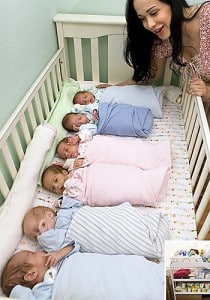Dr. Jain Answers Questions About IVF and The California Octuplets
 There has been intense international reaction to the birth of octuplets by a Southern California woman. While the details are not fully available, it appears that several frozen embryos were transferred to the uterus of a 33 year old woman resulting in the birth of 8 infants. Dr. Jain has been interviewed by news agencies from around the globe for his comments and perspective. The following is a summary of the most common questions and excerpts from his interviews:
There has been intense international reaction to the birth of octuplets by a Southern California woman. While the details are not fully available, it appears that several frozen embryos were transferred to the uterus of a 33 year old woman resulting in the birth of 8 infants. Dr. Jain has been interviewed by news agencies from around the globe for his comments and perspective. The following is a summary of the most common questions and excerpts from his interviews:
Who qualifies for in-vitro fertilization?
There are no set qualifications for in-vitro fertilization services. Patients should be assessed for medical, psychological and social well-being. Unique to the specialty of fertility is the health and welfare of the unborn child or children. I try to educate and counsel my patients and make a responsible decision in partnership with the intended parents.
Since this young, single woman lives at home and already has 6 children from in-vitro, is it ethical to help her have more?
It is not my role to dictate how many children a person can have. However, since she represents a situation well outside the norm, I would have recommended psychological evaluation and evaluation of her social situation prior to assisting her with additional pregnancies.
Are fertility services regulated? As a result of this case, will there be more regulations?
There are no specific regulations dictating the practice of infertility. The American Society of Reproductive Medicine has created practice guidelines based on scientific evidence that aid practitioners in the safe and effective provision of fertility services. Most fertility doctors follow these guidelines responsibly. The case presented here is an exception and should not be used as the basis for wide-sweeping rules and regulations. Patients should not be fearful that such rogue behavior is common.
Are there guidelines on how many embryos should be transferred?
In general, for women under the age of 35, no more than 2 high-quality fresh embryos or 3 frozen embryos should be transferred. These guidelines exist to prevent multiple pregnancies which carry with them significant risk for premature birth and life long disability or death. The apparent transfer of at least 6 frozen embryos was well above the standard. I am uncertain why they were not transferred in smaller groups of 2 or 3. As a result, both the mother and the children were put at great risk.
What will happen to the fertility doctor? Will the doctor lose his/her license?
We have Medical Boards for this very purpose. They will no doubt investigate this case, gather all the facts, and determine whether sanctions are warranted. The doctor may be put on probation or have his medical license revoked.

 company
company
Leave a Reply